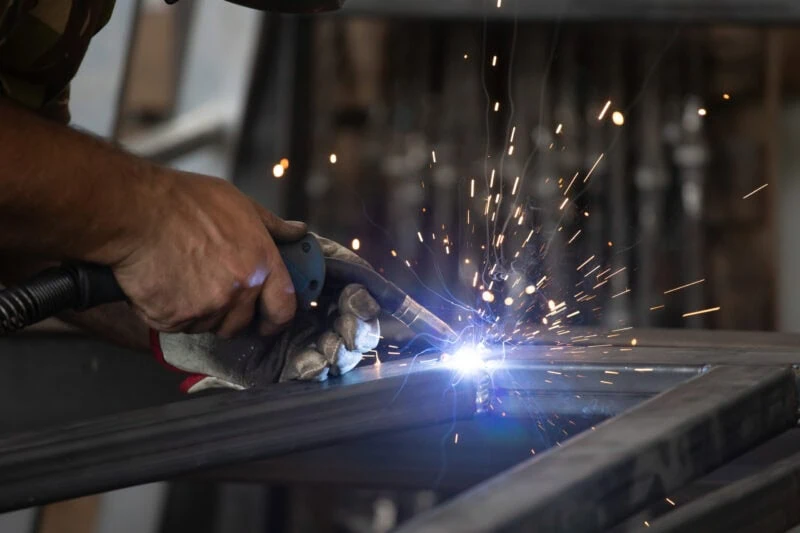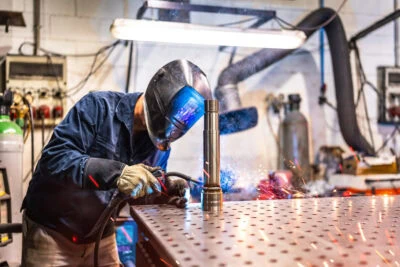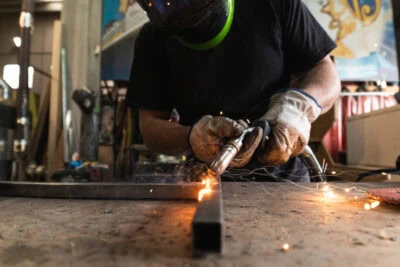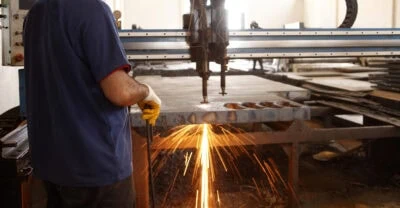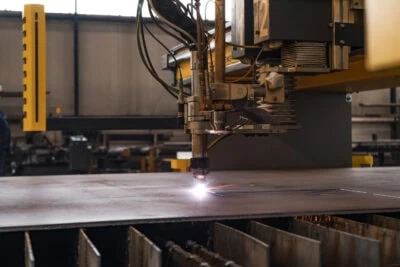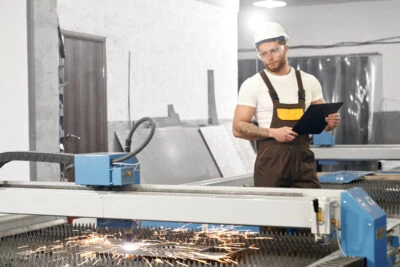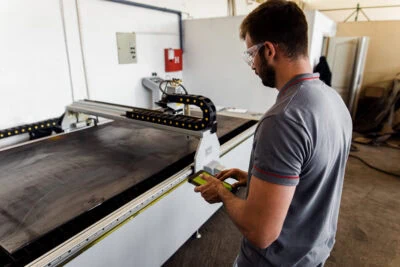Are you familiar with the terms metal fabrication and welding? While often used interchangeably, these phrases describe distinctly different processes with unique requirements.
With access to the best technology and tools available, an expert in metal fabrication and welding can help with every aspect of the manufacturing process. This includes everything from metal cutting to the final welding process to create complete metal products.
However, before getting started, read on to uncover how metal fabrication and welding play a key role in the entire process of turning raw sheet metal or metal pieces (or even other materials) into intricate metal products that are ready for market.
What is Metal Fabrication and Welding?
In the simplest terms, metal fabrication and welding are the processes used to shape, cut, bend, and/or join or piece metal together to create a final metal product. Many different tools and steps are involved in the production process. They are used to create these individual or joined metal pieces, as well as varying types of raw materials – or different types of metal – that can be utilized for any metal fabrication and welding venture.
Table of Contents
What Does a Metal Fabricator Do?
What is the Metal Fabrication Process?
What is Welding Fabrication?
The Four Main Welding Processes
How Metal Fabrication and Welding Tie into Laser Cutting
Advantages of Metal Fabrication and Welding Services
Start Your Next Welding and Fabrication Project
Understanding Metal Fabrication
Metal fabrication is the more significant collection of tasks and steps required for making defined metal pieces or whole products. Often too complicated to conduct in-house for smaller companies and manufacturers, a metal fabrication shop or metal fabrication services provider is enlisted to complete entire projects. That is because they have the resources and experience required for all aspects of the metal fabrication process. These specialists are sometimes referred to as metal fabricators.
What Does a Metal Fabricator Do?
A metal fabricator, or a specialized team of metal fabricators like the team you’ll find at Steelway Laser Cutting, has a long list of roles. The metal fabricator’s job shifts based on the metal product they are constructing. Therefore, each distinctive project typically entails multiple metal fabrication tools to create individual metal parts or complete metal structures.
A metal fabricator facilitates all the required steps of a metal fabrication project, such as metal cutting, bending, and engraving. This also includes adding finishing touches like powder coating. A metal fabricator is often an accomplished welder with an intricate knowledge of varying welding and fabrication techniques.
According to the United States Bureau of Labor Statistics, approximately 1.48 million people work in the metal fabrication industry in the U.S. as a metal fabricator of some variety. However, a metal fabricator may have a more well-defined position, such as a machinist, millwright, cutter, bender, assembler, or welder. A metal fabricator may also be a designer or engineer of metal products and may oversee the metal fabrication process from start to finish.
What is the Metal Fabrication Process?
The complete metal fabrication process varies based on the individual metal components or raw metal materials, and the different methods and fabrication techniques required to finish the job.
However, as a general guideline, the metal fabrication process usually flows through the following steps.
Metal fabrication project bidding and/or estimate
Metal fabrication begins with estimating the cost to create the metal parts or pieces required by the manufacturing company or business. The best way to achieve a precise and accurate quote for the metal fabrication involved is to provide a detailed design to your metal fabricator or fabrication services provider with all the specs for the ensuing project.
Many modern metal fabrication companies prefer computer-aided design (CAD) file. This file provides precise details on the metal fabrication project to come, and it works seamlessly with various tools involved, such as a metal laser cutter.
Metal fabrication planning
Once you establish a partnership between a business and a metal fabricator, intricate planning can provide a better scope of the metal fabrication process, the timeline, and the work involved.
If multiple steps are required, like welding metal parts or metal pieces together, the metal fabrication process will naturally take longer to complete. However, the best metal fabrication companies, like Steelway Laser Cutting, are known for their speed and ability to meet tight deadlines. Despite the complex nature of metal fabrication projects, the team at Steelway consistently delivers every project on time.
Once the design and specifications for the project are final, the metal fabrication process can begin.
During the metal fabrication process, raw materials like stainless steel, aluminum, copper, brass and other materials start to be transformed into a finished product.
Generally speaking, sheet metal is typically cut using advanced tools like a laser cutter and then pieced together with welding methods and tools. These factors can vary depending on the project specifications.
Simply put, welding may be one step of the process. However, metal fabrication entails many steps that turn ordinary metal surfaces into finalized metal parts and products.
Welding
As stated, welding is a common action that may or may not be necessary in metal fabrication. Furthermore, welding is a highly skilled trade that requires an expert technician to complete.
What is Welding Fabrication?
In welding fabrication, two pieces of metal are fused by heat, pressure, or, to connect the two metal parts into one. Welders tend to use various special tools that combine heat and pressure to create metal products without compromising strength. Therefore, the welding process generally falls into two categories:
- Fusion welding is the act of heating metal parts and then adding a filler to join them together into one whole metal product.
- Solid-state welding is a process that heats the individual metal parts and then joins them together without using additives or fillers.
Both fusion welding and solid-state welding can be used to create a complete metal product. In addition, the processes may be used for varying reasons that are typically dependent on the final design.
The Four Main Welding Processes Used in the Welding Industry
Fabricators use various welding methods to create metal designs. . The four main welding processes in metal fabrication include the following.
- Shielded metal arc welding (SMAW): SMAW welding is arguably the best-known type of welding and one of the main welding processes in the metalworking industry. This type of welding, also known as stick welding, is a fusion method involving an electric current and consumable welding rods, which act as fillers between the metal surfaces being joined.
- Oxy-acetylene welding (OA): Oxy-acetylene welding is another common welding method. This welding method combines a tank of oxygen and a tank of acetylene through a torch nozzle. The flame heats the metal in this welding process, while a filler rod allows metal fusion.
- Tungsten inert gas welding (TIG): TIG welding is often known as the most refined type of welding because of the high-quality results you will see from the welding process. TIG welding is effectively a two-hand procedure, as the welding fabrication involves using a non-consumable tungsten electrode to drive the process.
- Gas metal arc welding (MIG): This welding process is a wire-feed welding method with a consumable rod fed from a continuous spool of electrode wire. MIG welding is one of the most popular welding techniques for certain materials. It is excellent for thin stock and sheet metal welding projects.
More Information About Welding Techniques
Keep in mind that welding techniques do not begin and end with the above welding methods. Furthermore, you can use several fabrication and welding techniques depending on the specifics of your design, the metal required for the product, and your overall metal project.
An expert like Steelway Laser Cutting can guide you through these various fabrication and welding techniques. They also provide the utmost quality control and confidence that your metal fabrication and welding project will be handled perfectly from start to finish.
How Metal Fabrication and Welding Tie Into Laser Cutting
Laser cutting is an essential first step for projects that require welding to join metal parts together. This cutting method holds the reputation for being the most precise and detailed in the metalworking industry.
How the Laser Cutting Process Works
In advanced laser cutting, the CAD file or design is fed to a computer numerical control (CNC) laser cutting machine, which is designed to automatically follow the specifications of the detailed cuts. Once the cutting starts, the process can continue without deviation or human involvement.
During the cutting process, the laser beam is directed onto the sheet metal as the metal pieces are cut and created repeatedly, with no deviation from one metal piece or part to the next. The laser beam effectively vaporizes the material, using an assist gas to blow away any molten metal material and leaving behind precise cuts with no jagged edges, debris, or imperfections.
The process is repeated until the metal fabrication project is complete, and all the cut metal parts can be joined together in the welding process.
Why Do Professionals Prefer Laser Cutting for Metal Fabrication and Welding?
When it comes to joining metal parts, laser cutting is the preferred initial step in the metal fabrication process simply because it is so precise and error-free. Since every part is perfectly cut, joining metal parts through welding applications is easy and does not require any additional steps.
Simply put, the welding portion of the metal fabrication process runs smoother, because the laser cutting ensures that all metal parts easily and perfectly fit together.
Advantages of metal fabrication and welding services
As noted, metal fabrication encompasses a specialized range of knowledge in metalworking techniques. This includes laser cutting metal sheets and joining metal parts via welding to create a finished product.
This is why many companies and manufacturers rely on an expert metal fabrication services provider to create and assemble metal structures. Therefore, it is a partnership that can have a world of benefits, such as the following.
1. Saves Time
Relying on an expert laser cutting and metal fabrication services provider saves ample time on the process, as the metal fabricator has access to the special tools and expertise required to complete every project. With advanced technology in various steps of the process, like utilizing cutting-edge laser cutters, the entire manufacturing process is simply faster from start to finish.
2. Saves Money
Companies can save money when they partner with a metal fabrication provider for many reasons. All of the special tools and technology required for metal fabrication can be too costly to acquire in-house. Metal fabricators have access to a broader range of tools and technology to achieve better, faster results.
In addition, since there are no missteps due to this technology that is driving the process, companies save money by eliminating mistakes, debris, wasted material, and other costly errors.
3. Fosters Innovation
Imagine what designs you could bring to life if you had the power of the best technology, machinery, equipment, and operating technicians behind the scenes and doing the heavy lifting of the manufacturing process.
This is exactly what a metal fabricator can provide. With the intricacy and precision of laser cutting machines, no design is too detailed when it comes to metal fabrication. This means that companies can create the best products on the market and can be as creative as they wish when it comes to metal parts and metal creations.
Start Creating Your Next Welding and Metal Fabrication Project with Steelway Laser Cutting
At Steelway Laser Cutting, we’re experts in every aspect of the metal fabrication process. Our expert team uses the latest technology, the most advanced laser cutting machines, and decades of expertise for every project.
With a focus on our clients’ satisfaction and a consistent track record of meeting and exceeding expectations, we’re the best resource for any metal fabrication project in any industry.
Connect with us today to start the conversation.
Together, we can streamline your operations while giving your company the freedom to make any creative metal fabrication idea a successful reality.
